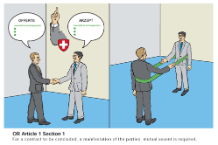1.
Motivation ^
2.
Foundations ^
3.
Requirements for the Meta Modeling Formalism by Using an Example ^
- First, it has to permit the definition of elements and relations between elements.
- Elements and relations have to be typed to represent classes of elements and relations.
- It must be possible to group elements and relations in order to describe a particular visual law representation or parts thereof – e.g. two images as shown in figure 2.
- The relations can either be defined as first-class-objects or may also be defined as elements that offer ways to link to other elements if necessary. Relations should in any case also be able to cross boundaries between different groupings of elements.
- It must further permit the addition of attributes to elements and – if separately defined – relations. These attributes can then be used to characterize the properties of the elements and relations. Furthermore, attributes must also be typed and must permit to link to other elements in the same or a different group.
- It must permit the specification of a graphical representation for the elements and relations, in particular in the form of iconic images.
- In order to structure the classes of elements and relations and to permit the use of polymorphic behaviors when designing algorithms for the resulting modeling languages, the formalism should also provide inheritance for classes and classes of relations.
- The formalism should be easy to use and not require extensive mathematical knowledge to be practicable also for users in visual law with little or no technical background.
4.
Conclusion and Outlook ^
5.
References ^
Brunschwig, C. R., Multisensory Law and Legal Informatics - A Comparison of How these Legal Disciplines Relate to Visual Law. In: Geist, A., Brunschwig, C.R., Lachmayer, F. & Schefbeck, G (eds.), Strukturierung der Juristischen Semantik – Structuring Legal Semantics, Editions Weblaw, Bern, p. 573-668 (2011).
Fill, H.-G., A Polysyntactic View on the Encoding of Semantics in Legal Visualizations. In: Schweighofer, E., Geist, A., Heindl, G. & Szücs, C. (eds.): Komplexitätsgrenzen der Rechtsinformatik, Richard Boorberg Verlag, p. 548-556 (2008).
Harel, D., Rumpe, B., Meaningful Modeling: What’s the Semantics of "Semantics"?. IEEE Computer, October 2004, p. 64-72, (2004).
Kahlig, W., Visualisierungstypologie des Deutschen Privatrechts. In: Jusletter IT 24. Februar 2011, (2011).
Karagiannis, D., Kühn, H., Metamodeling Platforms.In: Bauknecht, K., Tjoa, A.M. & Quirchmayr, G. (eds.): Third International Conference EC-Web 2002 – Dexa 2002, Springer, Aix-en-Provence, France. p. 182 (2002).
Kern, H., Hummel, A., Kühne, S., Towards a Comparative Analysis of Meta-Metamodels. 11th Workshop on Domain-Specific Modeling 2011, URL: http://www.dsmforum.org/events/DSM11/Papers/kern.pdf (last access 05-01-2012).
Olbrich, S., Visualisierung von rechtlichen Rahmenbedingungen in Geschäftsprozessmodellen. In: Schweighofer, E., Geist, A., Heindl, G. (eds.), 10 Jahre IRIS: Bilanz und Ausblick, Richard Boorberg Verlag, p. 474-479, (2007).
Sauerwald, M., Mind Mapping als Visualisierungsmethode in der juristischen Praxis. In: Schweighofer, E., Geist, A., Heindl, G. (eds.), 10 Jahre IRIS: Bilanz und Ausblick, Richard Boorberg Verlag, p. 480-485, (2007).
Sprinkle, J., Rumpe, B., Vangheluwe, H., & Karsai, G., Metamodelling - State of the Art and Research Challenges. In: Giese, H. et al.: MBEERTS, Springer. p. 57-76, (2010).
- 1 See the current version of the visual law database maintained by the University of Zurich that comprises more than 15.000 images: http://rwiweb.uzh.ch/rechtsvisualisierung/release2/ (last access 28-12-2011).
- 2 See http://graphml.graphdrawing.org/ (last access 03-01-2012).







